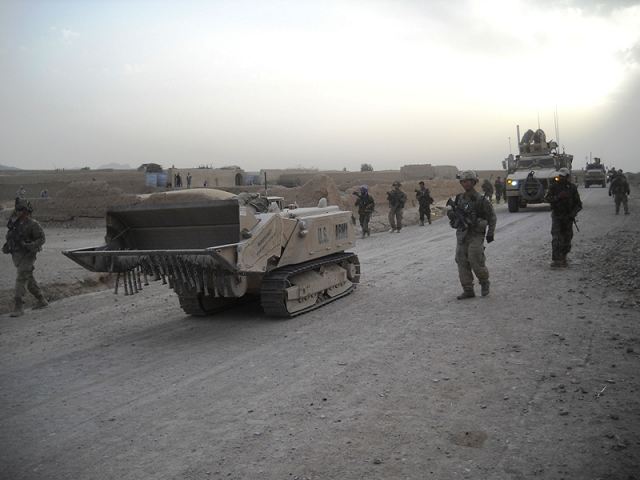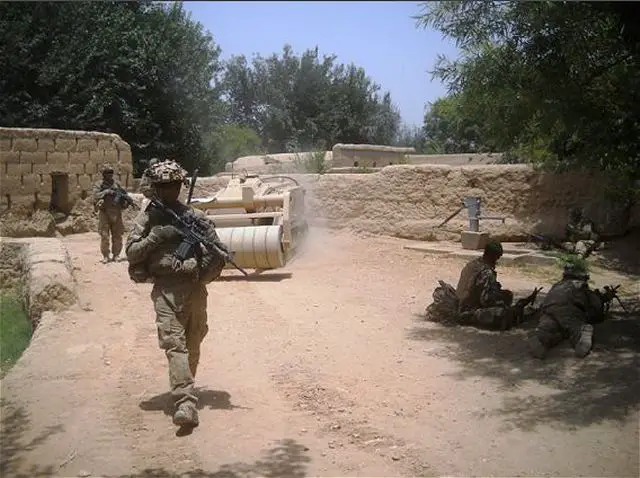Breaking news
U.S. army combat engineers soldiers keep the road safe in Afghanistan with new technologies 0808111.
| a | |||
Defense News - United States |
|||
|
|||
| U.S. army combat engineers soldiers keep the road safe in Afghanistan with new technologies. | |||
Due
to the unique mission requirements in 3rd Brigade Combat Team, 10th Mountain
Division’s area of operations, Spartan combat engineers in Alpha
Company, 3rd Brigade Special Troops Battalion, have adapted to meet the
requirements of Kandahar province, Afghanistan. |
|||
 Soldiers with Alpha Company, 3rd Brigade Combat Team, 10th Mountain Division walk alongside the Doking mine clearance vehicle during a recent patrol in Zharay district, Kandahar province, Afghanistan. The Doking is a remote-controlled robotic vehicle that is used for mine clearance and route clearance, allowing operators and Soldiers to stay behind cover while the Doking is in use. (Photo Credit U.S. Army: Capt. Jason Allen) |
|||
A combat engineer company’s standard mission on deployment is route clearance. Typically, a route clearance mission consists of patrolling roads in the brigade’s area of operations and clearing them of improvised explosive devices, or IEDs, before a convoy uses the road. The purpose of a route clearance patrol, or RCP, is to allow other units to accomplish their mission without obstacles or unnecessary injury or enemy contact. Instead of being an RCP for example, many of the combat engineers are being attached to infantry units on dismounted patrols and using new technologies to clear the route ahead of the unit.“In Iraq, I did RCP, so I was mounted all the time,” said Spc. David Reynolds, a combat engineer and Doking operator in Alpha Company, 3rd BSTB. “Coming here and being dismounted, there is definitely a lot more to do.” The Doking MD4, a tracked vehicle which looks similar to a miniature armored personnel carrier, is operated with a remote control by a Soldier following the vehicle either on foot or in an armored vehicle. By putting the Doking before the patrol, the chances of a Soldier stepping on an IED are decreased drastically. |
|||
 Soldiers patrol a village in Zharay district, Kandahar province, Afghanistan, alongside a remote-controlled mine clearing vehicle called the Doking. (U.S. Army picture) |
|||
|
“It’s one of the Army’s remote operated
arsenals. It’s a robot with separate attachments,” said Sgt.
Adonys Lendof, squad leader in Alpha Company, 3rd BSTB. “It has
a flail, a mine roller, and a blade, and we use it to clear in front of
us, so we are not actually stepping on any IEDs.”
The Doking is about three feet high and about seven feet long. The engineers have four in their inventory that they can use every time a battalion in the Spartan brigade requests its presence on a patrol. “It hasn’t hit any (IEDs) yet, but it keeps us and the infantry from being the first ones down the route,” said Lendof. Alpha Company Soldiers have a standard way of completing their mission as a team. “We take our whole squad (on mission),” Lendof said. “The Doking is in the front, the operator behind it with his security detail, and another engineer behind that with a mine detector.” The Soldiers are still adapting to their new mission in Afghanistan, and even though they are effectively using the equipment to clear roads of IEDs, most of them had never even seen the Doking until they deployed last March. However, they quickly learned how to use the equipment, and are glad for the added safety it brings them and other Spartan Soldiers. “I didn’t even know it existed until we got here, but it’s pretty easy to get the hang of,” said Pfc. Nate Oncea, a combat engineer in Alpha Company, 3rd BSTB. “(I) feel a lot safer walking down a route after [the Doking] has been down it.” Alpha Company Soldiers play an important role in the overall Spartan mission in Afghanistan, and their new equipment is helping them accomplish that mission. “We are providing mobility, counter-mobility (and) survivability to the infantry,” Oncea said proudly of his mission in Afghanistan. |
|||


























